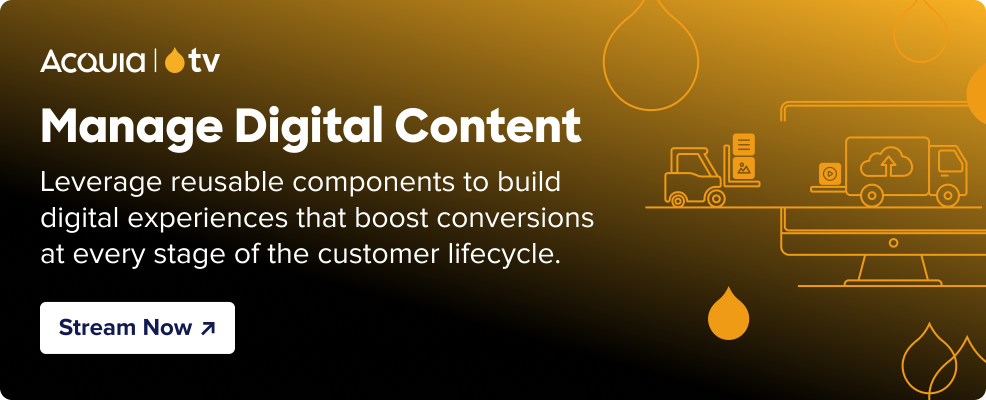What Is a Content Management System (CMS)?

Collection :
A content management system (CMS) is software that stores many content types, manages that content through its lifecycle, and publishes it to your website and other digital channels. In the past, they conducted the relatively straightforward task of managing and publishing web content. Now, it’s not as simple.
We’ll look at the ways in which the technology has evolved, how a CMS works, and what it looks like in action.
What does a CMS do?
| A CMS provides an easy-to-use interface that lets you modify the content you want, and then the CMS does the hard part: presenting that content on the web in a way that’s optimized for SEO, accessibility, and more. You don’t need to build a web page from scratch every time you want to release a new product, and you don’t need to update HTML just to add an image. These are tasks a CMS can address with just a few clicks — no coding required. |
Your CMS also stores the different versions of the content, which allows for version control, cross-team collaboration, content approval workflows, and content translation workflows. A traditional CMS publishes content to websites, but the world of headless and hybrid CMS platforms has allowed content management technology to reuse content across multiple channels.
How to use a CMS
When you need to make a change to your homepage, you can open your CMS and add text (meta description, headlines, title tags, etc.), images or video, and publish other forms of content.
Want to publish a blog post? Just enter the copy and media into the CMS and schedule it for publication.
Media companies know the drill well. They use content management systems to write, schedule, and publish articles read by millions of people. With the right content management system, an editor or writer can use their smartphone to make real-time updates to articles based on breaking news.
The best content management systems make users feel like they can create or change any content they need without asking for help from IT. That ease-of-use can add significant workflow efficiencies, increased collaboration across teams, omnichannel content publishing, and much more.
Benefits of a CMS
A CMS helps organizations deliver content for digital experiences more efficiently and cost-effectively. Your business can use a content management system to meet a variety of high-level strategic goals and consolidate your marketing technology (martech) stack to save on software run costs, but there are other advantages worth identifying. Not every CMS will deliver the same value, so when comparing systems, see which of your top choices have the features and functionalities that will net you most of what you’re looking for:
- Provide a centralized content management platform for end-to-end content production
- Support rapid production of new digital experiences
- Deliver personalization tools with low technical entry costs for marketers
- Integrate easily with other technologies in your martech stack
- Enable multisite functionality and seamless collaboration on one platform
- Share content to all sites and devices without requiring multiple content versions
There are even more advantages to using a CMS, but let’s go through the types of CMSs available to you.
Types of CMS
As technology introduces new ways of engaging customers and interacting with content, your content management system may have trouble keeping up. Early CMS platforms had it easy, because they served simple content to static web pages. Today’s systems, however, are expected to manage content for an ever-expanding collection of front-end platforms and devices.
From websites and native mobile apps to smart speakers and smartwatches, as well as digital signage and virtual reality platforms, your CMS is expected to provide content for increasingly diverse formats while engaging audiences, driving revenue, and promoting brand awareness.
That expectation has led to the rise of four primary content management systems: headless, open source (e.g., Drupal), hybrid, and software as a service (SaaS). There can be overlap between them, i.e., a CMS can be both headless and open source.
- A headless CMS is a cloud-based content management system that can provide content to multiple channels and devices via API endpoints. It’s a CMS where the front end that renders content is decoupled from the back end, where content is created, managed, and stored.
- An open source CMS, like Drupal, has a flexible modular design that eases the creation and management of websites and other digital experiences. Open-source CMSs are supported by large communities of developers, are highly scalable, and easier to integrate with an open source tech stack.
- A hybrid CMS combines attributes from both traditional and headless CMS types. Created and stored in the database, content can be served flexibly, either through the existing, coupled front-end rendering layer or retrieved by a completely separate, decoupled front-end layer via APIs.
- A SaaS CMS is a cloud-based service that hosts all your content management functions and integrates with other popular services. SaaS content management is purpose-built for specific content presentations and not always as customizable as other CMS types. Wix is one example of a SaaS CMS.
There are still more ways to categorize content management systems. Here’s another take:
There are DXP suite-CMS players that are deeply immersed in delivering solutions for digital experiences, including a CMS. These digital experience platform (DXP) suite players typically only provide integrations or exclusively focus on integrating their own solutions, forcing customers to choose only their products or create their own custom integrations. Some systems that fall into this category include Adobe, Optimizely, and Sitecore.
Another category relates to best-of-breed CMS players. To deliver on a DXP strategy, those content management systems focus on integrating with other solutions considered the best of their kind. Some examples of best-of-breed CMS players are Drupal, WordPress, SDL Tridion, and Teamsite.
How to choose a CMS solution
When it comes to selecting a CMS platform, must-haves for marketers include support for personalization, a seamless behind-the-scenes authoring experience, and the flexibility to connect with other systems in their martech stack. Additional requirements to consider when choosing a CMS include:
- Centralized platform for storing content in an open, non-proprietary format and for sharing content with all sites and devices without requiring multiple instances
- Custom design possibilities for each website, mobile app, and digital experience
- API-first infrastructure that gives front-end developers greater flexibility for rendering content
- Responsive design
- Ability to easily maintain and upgrade the system without intervention from IT and to deploy functionality updates quickly as new technologies and platforms emerge
- Tools that allow teams to work together with common workflows on a single platform
- Capabilities for personalization that less technical marketers can use
Choosing a CMS requires different processes unique to your organizational needs. Fortunately, you have a thorough guide that can walk you through the process of choosing a CMS.
Content management system examples
There are many content management systems on the market, and it can be a long process to identify one that meets all your needs. Here’s a short overview of some of the options.
Drupal
Drupal is a flexible, open-source CMS solution with a modular design that makes it easy to create and manage websites, applications, and other digital experiences without needing to write code. It’s so flexible that it can be configured for headless and hybrid CMSs too.
It’s also highly scalable, enabling content to be published in multiple languages across many devices, as well as supporting unlimited users and content types.
Drupal is supported by a large community of users who continually modify and extend the platform. It has eyebrow-raising advantages over other content management systems. Organizations like Nestle, Princeton, and Paramount all use Drupal.
WordPress
As a blogging and landing page tool, marketers claim ease of use as a hallmark of this CMS. WordPress is also used to build and manage websites for some of the world’s most influential companies, such as The Walt Disney Company, Spotify, and NBC.
Like Drupal, WordPress is open source software that allows for a wide variety of customizations to meet your needs. If you want to learn more about its capabilities as a CMS, read how WordPress compares to Drupal.
Sitecore
Sitecore is a proprietary CMS that relies on third-party providers to deploy its solution in the cloud and connect it to all your martech and customer data sources. This means that if a customer requires cloud deployment, the deployment model comes with an additional cost. While that may give buyers looking for a CMS pause, users find a lot of value in the software’s content taxonomy, community / comment management, and SEO support.
Some of the largest companies in the world, including PUMA, United Airlines, and L’Oreal, use Sitecore. It makes sense for some large enterprises, but there are a few reasons why an open-source CMS like Drupal may be a better alternative.
Adobe Experience Manager (AEM)
Like Drupal, Adobe Experience Manager (AEM) is an open source system built on Java. A cloud-native platform, it’s a combination digital asset management (DAM) and content management system used by brands such as Ford, T-Mobile, and GoPro.
According to TrustRadius, popular features of AEM include its role-based user permissions, mobile optimization, and page templates. But, to access some of the marketing capabilities that the software claims, Adobe doesn’t often tell users that they need to purchase many of the company’s products separately. That may be a factor that offsets AEM’s attractions.
Optimizely
Also an open, extensible platform in the cloud, this SaaS CMS sits under the Optimizely Content Cloud along with many of the company’s products. Used primarily by midsize companies, Optimizely is known for features like its role-based permissions, the cleanliness and quality of its code, as well as its publishing workflow. Some users have described the documentation that Optimizely offers for its headless technologies as limited and that the system seems to be down often, affecting reliability. Businesses such as Ebay, Dolby, and Pizza Hut use Optimizely.
Getting started with a CMS platform
A CMS that just publishes content to a website (or a family of websites) is a legacy tool in today’s digital landscape. It’s about much more than updating web pages — you need to gather content from many sources and send it to a long list of front-end applications. For example, your developers might need to code a customer-facing smartwatch experience and deliver content from the CMS via API.
It’s likely that a blend of CMS types will give your company all the benefits it needs from a content management platform. Drupal is a hybrid headless CMS that’s agile and enterprise-ready. Acquia CMS Starter Kits for Drupal offer pre-packaged versions of Drupal with enhanced capabilities exclusive to and maintained by Acquia to accelerate your Drupal projects. If you’re looking for a new CMS or want to get started on the right foot, schedule a demo here to see Drupal in action.


